#barkandji people
Text
Years later, this early work from Merrima Design holds up as an excellent example of biophilic design.

"Design: Building on Country" - Alison Page and Paul Memmott
#book quote#design#building on country#nonfiction#alison page#paul memmott#merrima design#hospital extension#wilcannia#biophilic design#barkandji people
1 note
·
View note
Text

Over countless millennia, Aboriginal and Torres Strait Islander peoples have harnessed the tremendous potential of plants, ingeniously using them for medicines, nutrition, to express our culture and to develop innovative technologies. But as I learn more about First Peoples’ plant knowledge, I’m also better understanding the broader Australian community’s failure to recognise the depth and breadth of our expertise.
Aboriginal people, our culture and deep knowledges are often seen as “in the past”, fixed and stagnant. Damaging perceptions which cast us as lesser and posit us as a homogenous peoples [...] still abound. Such tropes deny our dynamic place in the present day [...]. I’ve listed five of my favourite Indigenous plants and the multiple ways Aboriginal people used them, and continue to do so. [...]


Spiny-headed mat-rush is a large tussocky plant found throughout southeastern Australia. The Wurundjeri people particularly favour this plant for weaving cultural items such as necklaces, headbands, girdles, baskets, mats and bags for carrying foods [...]. Its seeds are high in protein. They can be collected and pounded into a bread mix, with the core of the plant and the base of the leaves eaten as a vegetable. Many diverse Aboriginal peoples use the roots to treat bites and stings. The caterpillars of several butterflies, such as the Symmomus Skipper, also rely on this plant for food and habitat.


Aboriginal peoples from many diverse groups favour the fibrous kurrajong bark for making string for fishing lines, nets and bags, as well as body adornments such as headbands. Flowers turn to fruit in the form of leathery pods. These pods contain highly nutritious yellow seeds, which contain around 18% protein and 25% fat, and high levels of magnesium and zinc. [...]


Favouring dry conditions, black sheoak is native to Queensland, Tasmania, NSW and Victoria, and can grow up to eight metres high. It flowers in spring, with either rusty-brown spikes or red flowers that develop into cones. Its seeds are an important food source for many native birds, including parrots and cockatoos. Diverse groups of Aboriginal peoples use sheoaks for various purposes. The shoots and cones can be eaten, and sheoak wood can be used to fashion boomerangs, shields, clubs and other cultural implements because the wood is both strong and resists splitting and chipping. In fact, the earliest evidence of boomerangs, found in the Wyrie Swamp in South Australia, were made from various sheoak species, and were dated at 10,000 years old.


In summer, bulbine lily dies back to a dormant bulb, before re-shooting in late autumn. In spring, it displays vibrant yellow flowers. Bulbine lilies can be found in all states except Western Australia, growing wild in tandem with milkmaids and chocolate lilies in the few areas of Victoria’s undisturbed remnant vegetation. It’s considered the sweetest tasting of all edible root plants and is available year-round. You can find a plump, round, cream-coloured storage organ (a type of underground stem) under its stalk, which can be eaten after being roasted. Bulbine lily is also nutritious, a good source of calcium and iron.

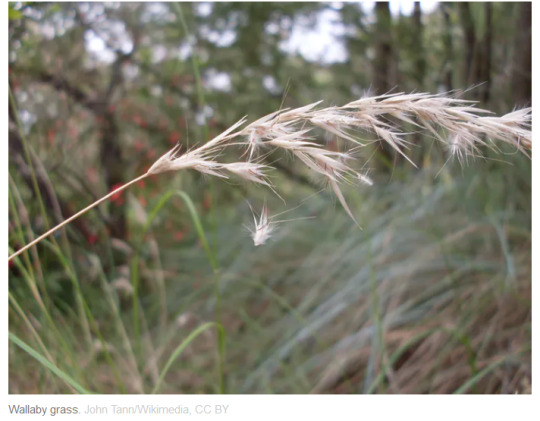
There are around 30 types of wallaby grass in Australia. Native grasslands were once the most extensive habitat of Victoria’s western plains, but are now the most endangered plant community.
Grasslands provide food and habitat for a huge diversity of fauna, particularly birds, such as the peregrine falcon, whistling kite and Australian kestrels. Many animals, such as the legless lizard, little whip snake and fat-tailed dunnart, were once commonplace, but are now scarce in this endangered ecosystem.
Wallaby grass seeds make an excellent bread by pounding them into flour. The leaves and stem are also used to make cultural items, such as nets for fishing and hunting. It’s also incredibly hardy – highly tolerant to frost, heat and drought, and requiring no fertilisers and little water. And it makes an excellent lawn, controlling erosion and weeds.
-------
Headline, images, captions, and text published by: Zena Cumpston (Barkandji). “Food, tools and medicine: 5 native plants that illuminate deep Aboriginal knowledge.” The Conversation. 20 October 2020.
179 notes
·
View notes
Text
Indigenous Artists Reflect on Climate Crisis – In Pictures
Aboriginal and Torres Strait Islander peoples’ cultural knowledge and sophisticated understanding of weather systems is the cornerstone for Big Weather, an exhibition currently showing at NGV Australia’s Ian Potter Centre. Climate crisis is never far from the surface, with works from artists like Karla Dickens, Clinton Naina, Treahna Hamm and Nici Cumpston addressing the changing weather patterns and the ongoing effects of colonisation on the land and its processes.
• Big Weather will be showing at the Ian Potter Centre: NGV Australia, Melbourne, until 21 October
— Tuesday 13 April 2021 | Guardian USA

Nookamka – Lake Bonney (2007) by Nici Cumpston! Nici Cumpston is a Barkandji artist from the Barka, or Darling River in far west NSW, and is compelled to make work that testifies to the ongoing plight of the people and the waterways of the Murray-Darling basin. In this series of works the artist has spent time walking and documenting the backwaters of this incredible river system with the aim to raise awareness of the fragility of this vital resource and the vulnerability of the people, animals and plants that rely upon it.

Flooded Gum, Katarapko Creek, Murray River National Park (2007) by Nici Cumpston! This piece was created during a major drought following a decision to pump water back in to this precious river red gum forest, enabling the saplings to grow.
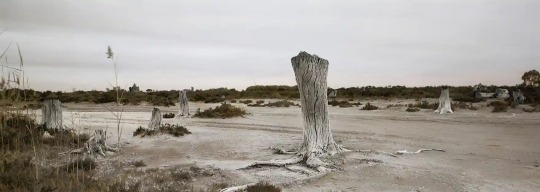
Tree stumps, western shoreline – Nookamka (2007) by Nici Cumpston! All of the works in this series show the direct impact of changing weather patterns and human control of water flow. This one shows the shoreline of this inland lake. In this case, the flow of fresh water in to the lake was stopped so the water could be kept in the River Murray. This had catastrophic effects on the fish and bird life as well as the livelihoods of those living alongside it. The stagnant water became incredibly saline and sulphuric acid rose to the surface, which reeked of rotten egg gas.

Rockholes and country near Kata Tjuta (2007) by Bill Whiskey Tjapaltjarri! ‘[Tjapaltjarri] tells the story of the cockatoo who was attacked by the cheeky crow while preparing to lay her eggs ... The result of the clash lies in the formations of white stones scattered across the landscape, and an overlooking hill that is the embodiment of the eagle spirit.’ – Hannah Presley
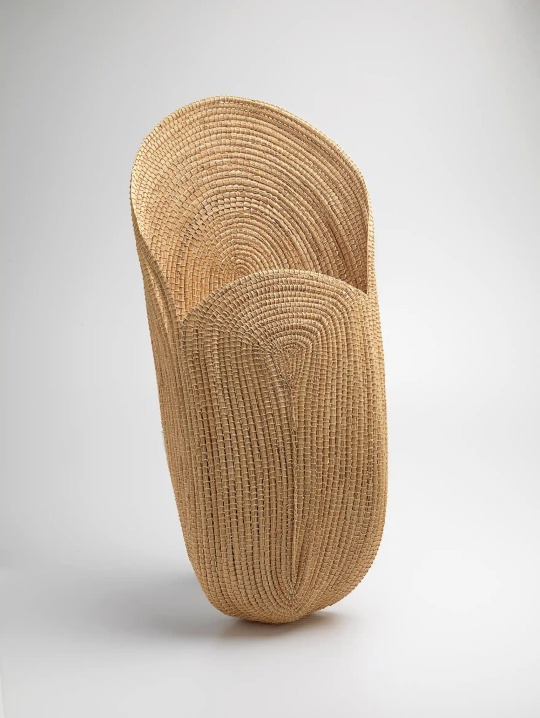
Fish scoop (2010) by Yvonne Koolmatrie! ‘Senior Ngarrindjeri weaver Yvonne Koolmatrie has woven a fish scoop out of sedge, using the Ngarrindjeri coiling technique. Women customarily used scoops to collect fish caught in nets and to entrap fish, yabbies and crayfish in the shallows. By making such cultural objects, Koolmatrie connects with the river, her Country and her ancestors.’ – Hannah Presley

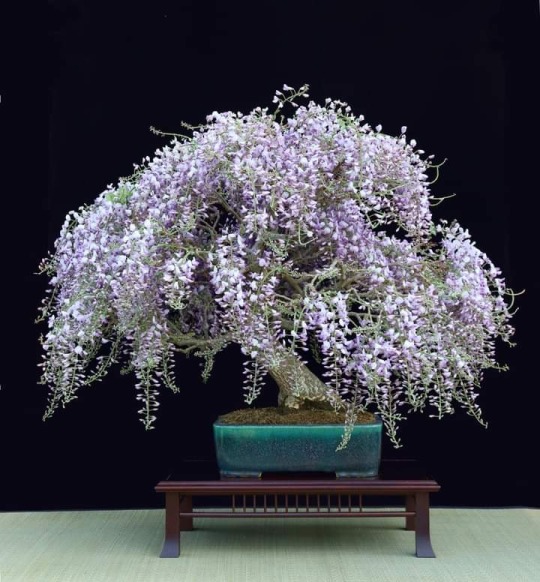
8 notes
·
View notes
Photo
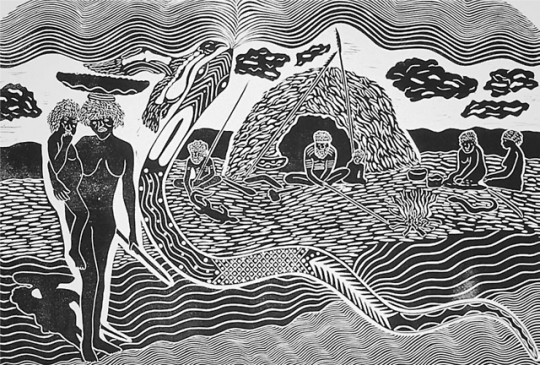
Endangered Languages Challenge : Paakantyi Palku
Name: Paakantyi also Barkindji; Barkandji; Paakantji; Baagandji
Genealogical Affiliation: Pama-Nyungan
Location: Far-West New South Wales, Australia (bordering on South Australia, Victoria, and Queensland). Namely Bourke; Wilcannia; Menindee; Wentworth; Broken Hill; Pooncarie
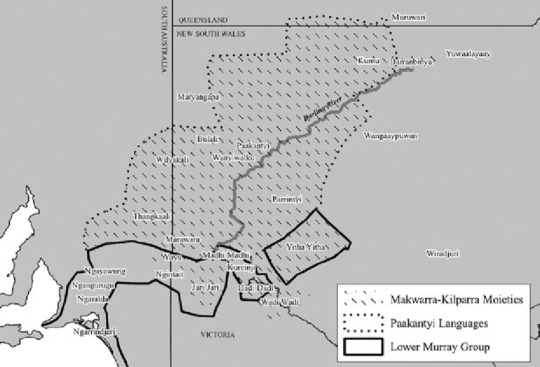
Number of Speakers: Low to mid-twenties recorded on Australian Bureau of Statistics census. More in remote communities.
Why is the language endangered? Step 2 of Process of Colonisation as outlined by Prof Virgilio Enriques: Destruction/Eradication. There is a direct link between colonisation, assimilation, and cultural genocide and the decline in native speakers of Paakantyi and its dialects.
Speaker Community: The most widespread dialect is Southern Paakantyi, the language of Pooncarie and Wilcannia. Most speakers are on either side of the Makwarra-Kilpara moiety kinship system.


There are maintenance and revitalisation efforts across all locations, most notably in Menindee, Wilcannia, Bourke, Wentworth, and Mildura. These are led by Paakantyi Elders and educators, and operate in schools, TAFE, and community groups.
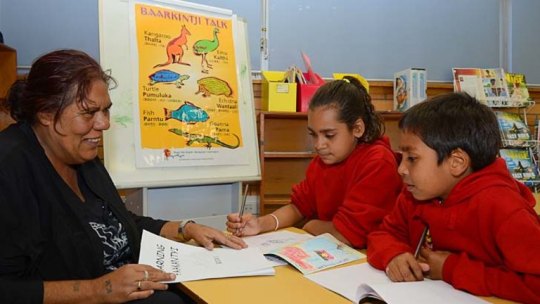
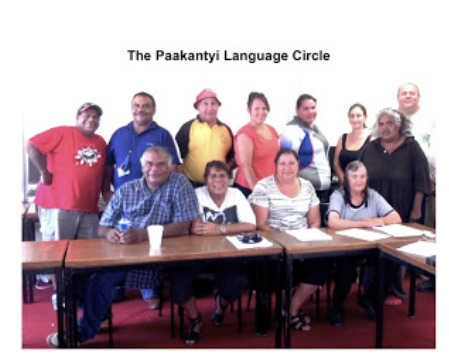
https://www.youtube.com/watch?v=B6aKm7WU4nM
Documentation: There are grammars; dictionaries; teaching and learning resources; and literature in Paakantyi Palku.



*Artwork by Uncle Badger Bates
Resources available from:
AIATSIS
Barkandji-Maraura Elders Environment Team
Maari-ma Health
Menindee Central School
Paakantyi Dictionary - Luise Hercus
Paakantyi Language Circle
University of Melbourne - Research Unit for Indigenous Language
Wilcannia Central School
Photo References:
NSW Department of Education & Training
Hope, Jeanette; Lindsay, Robert (2010). The People of the Paroo River: Frederick Bonney's Photographs (PDF). Department of Environment, Climate Change and Water, NSW. pp. 207–222.
#endangeredlanguageschallenge#endangered languages#endangered-languages#paakantyi palku#indigenous languages#aboriginal languages#paakantyi
81 notes
·
View notes
Text
Mungo Man: Australia's oldest remains taken to ancestral home
New Post has been published on http://usnewsaggregator.com/mungo-man-australias-oldest-remains-taken-to-ancestral-home/
Mungo Man: Australia's oldest remains taken to ancestral home
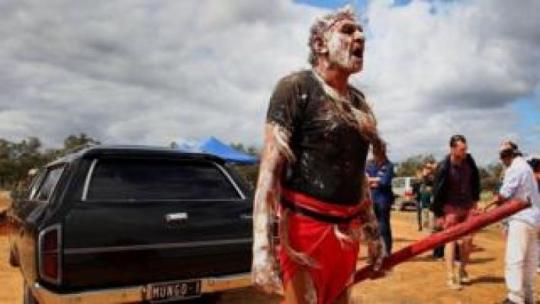

Image copyright Getty Images
Image caption The return of the remains was welcomed with a traditional ceremony
For decades, Australia’s oldest human remains – an Aboriginal man who died about 42,000 years ago – have been stored in a university and a museum.
But on Friday, the skeleton known as Mungo Man was brought back to his traditional home in New South Wales and honoured with a ceremony.
It marked the end of a long campaign by indigenous Australians to return Mungo Man to his original resting place.
The discovery of the skeleton in 1974 helped rewrite Australia’s history.
Research determined that Mungo Man had been buried in a complex funeral ritual, redefining scientific understanding of early Australians.
Who was Mungo Man?
The skeleton was unearthed by geologist Jim Bowler from a dry lake bed in Mungo National Park, about 750km (470 miles) west of Sydney, in what was hailed a major discovery.
Mr Bowler had already discovered the remains of a woman, known as Mungo Lady, in 1967.
Image copyright NSW OFFICE OF ENVIRONMENT & HERITAGE
Image caption Mungo Man’s repatriation was completed on Friday
The remains of Mungo Man were taken to the Australian National University in Canberra to be studied.
Carbon dating showed they were about 42,000 years old – Australia’s oldest known human skeleton.
Scientists determined that Mungo Man had been a hunter-gatherer with arthritis who died around the age of 50.
He was buried on his back with his hands crossed in his lap, and covered with red ochre. Scientists believe the ochre was most likely sourced about 200km from the burial site.
Distress over Aboriginal child’s exhumation
Long journey home
Indigenous Australians from the region have long called for the remains to be returned, saying his removal caused great pain.
Representatives from the Mutthi Mutthi, Ngiyampaa and Paakantji/Barkandji communities held a ceremony to mark the occasion on Friday.
“So good to have him back after all those years he has been taken away,” said Mutthi Mutthi elder Mary Pappin.
Image copyright Getty Images
Image caption The remains made a three-day journey from Canberra to Mungo National Park
“We have been waiting all those years to get him back and I’m so glad he is back, to put him in his resting place.”
He will be buried in a secret location in Mungo National Park. Mungo Lady was returned to the site in 1991.
The Australian National University relinquished the remains in 2015 and apologised for causing hurt over Mungo Man’s original removal.
In an article for The Conversation in 2015, Mr Bowler wrote: “In 1974, in that remote saltbush country between the rivers, Aboriginal advice remained unavailable to us.
“Subsequently, when Mungo Man’s discovery was announced, Aboriginal people expressed anger that this should have been done without the permission of Aboriginal people.”
For the last two years, the remains have been kept at the National Museum of Australia in Canberra while repatriation plans were being finalised. His remains, along with 104 others, were collected earlier this week.
The recovery of ancestral remains has often been a source pain for Aboriginal Australians. Campaigners say many skeletons removed without permission are yet to be returned, with some housed in museums overseas.
In July, archaeologists found the first evidence to suggest that Aboriginal people have been in Australia for at least 65,000 years.
Original Article:
Click here
0 notes
Text
One rural Indigenous community on what ‘Invasion Day’ means to them
In Australia, the date of Jan. 26 goes by many names.
“Australia Day” is what you might hear in media and on TV. But for many people, Indigenous or otherwise, it also goes by “Invasion Day” or “Survival Day” and it’s often called the “Day of Mourning.”
Marking the beginning of colonialism and the cultural loss, genocide and systemic racism that came along with it, the anniversary is a bank holiday marked by increasingly large protests and calls on social media to #ChangeTheDate. Or hell, even simply #CancelTheDate.
The town of Wilcannia found in outback north west New South Wales and belonging to the Barkandji people is made up of around 800 residents with diverse and deep-rooted emotions stirred around this date.
Artist and photographer Justine Muller spoke with Aboriginal residents of the town, on Jan. 26, taking their portraits with just her iPhone 7 Plus and asking them in their own words: What does Jan. 26 mean to you?
SEE ALSO: ‘You wouldn’t steal a car’: A safety message about celebrating ‘Invasion Day’
Leroy Johnson, Barkandji man
“Tick tock, tick tock tick tock, tick tock, it’s here again. The first month, the 26th day.” “The 26th of January” lyrics by Leroy Johnson.
Image: justine muller
“I wrote this song around 2010 I think. I wrote it in response sort of to the silly questions that you always get around this time of year, mostly from white fellas and the mainstream media about why we Aboriginals dont like the day and the date. The tick-tock part at the start is like, ‘Wait for it, the same questions will come.’
“Do I think the date should change? It is very significant to us, so the day should be acknowledged, but in a completely different way, like ANZAC Day for example (where Turkey celebrates the defence of their nation and ANZAC mourns the losses). We need to honour those who have died to defend their country against the foreign invader. Unfortunately, the invader now celebrates their victory and we mourn our losses. Different sides of the same coin.
“Australia should celebrate its nationhood, which is Jan. 1, 1901. The other date is just the establishment of a colony of Great Britain, not the birth of a nation. We (Australia) need to separate ourselves from Mothers (Great Britains) apron strings and grow up and form our own identity, which is definitely not a British Colony, as long as it stays this way, thats what we will be.”
Monica Kerwin Whyman, 47-year-old Barkandji woman
Image: justine muller
“1788 to 2017. Celebrating Australia Day traditions with family and friends drinking beer, having BBQ’s in back yards near rivers and on beaches across this nation is cultural for many non-Aboriginals to do on the Jan. 26 each year but the true traditional of this country we will mourn on this day because we have nothing to celebrate.
“We mourn for the loss of land on this day.
We mourn for the loss of our ancestors on this day.
We mourn for the loss of our children on this day.
We mourn for the loss of our identity on this day.
“Yes, Australia we will mourn on this day but we won’t do it in silence. We will march the streets. We will protest. We will raise our Aboriginal flags and we will make noise. Because we have asked you to change the date and you never listen. You have stolen a lot and gave back little to compensate for the wrongs you have done and yes, it has been over 200 years since you invaded our land yet you still celebrate on this day.
“You say you want to reconcile but what does that mean, Australia? You will never understand why we are angry on this day. You will never know the pain because you treat us like we are strangers in our own country and your non-Aboriginal generation will grow to know your Australia Day traditions but what do I give mine?
“So please change the date so we all can celebrate together. For all Aboriginals across this nation, it would mean a lot.”
Reena Staker, 35-year-old Barkandji woman
Image: justine muller
“It’s an insult to celebrate on a day that is an emotional time, especially for our elders. A lot of our history is still not recognised, and the truth is covered up. Australians need to be better educated about the reality then they would understand it is not a day of celebration for us.
“The Day should be on any other day, but not the day our land was invaded.”
Uncle Woddy Harris, 66-year-old Barkandji man
Image: justine muller
“I am an original Australian person. We are due for change. Stand up and say enough is enough let’s all come together. No more hating, we are all people. Australia is important to everyone. Life is about trust and choices. Lets choose to move forward together.
“If they want a day of celebration for all Australians then it’s not this day.”
Timothy A. Quayle, 47-year-old Barkandji man
Image: justine muller
“I think all Australians should have a great day on behalf of our great country.
“We are all Australians we should all celebrate together black and white. We should come together as one and get along.
“Im not a racist, I love everyone, so if they want to celebrate on that day I dont mind but I think there should be recognition of what happened, perhaps a minute silence as a sign of respect.
Alison Whyman, 44-year-old Barkandji woman
Image: justine muller
“Australia Day to me means Invasion Day. For us Aboriginal people it is nothing to celebrate. Even if you change the day Im still not sure how Id feel about it. It is hurtful to us. It’s a hurting day. We are still suffering.”
Brendon Adams, 40+ year-old Ku Ku Yalanji man
Image: justine muller
“The day of celebration for non-Indigenous, is about the landing in our country. They did steal our land even if politically they are ignorant to it. Admitting it yet still celebrating is ignorance and hurtful.
“For us to move forward together, the truth needs to be recognised.
Our people died for their country, and their blood has soaked this land.
“We have a minute silence for the Anzacs. Why cant we have a minute silence for our people who also fought for their country? I think if we did that people would start to understand and think about the past and we could take a step towards breaking down that ignorance.
“We Aboriginal people used to call Australia Day, Mourning Day but we now call it Survival Day. This change in attitude is an example of the strength of our people to want to move forward. In the past protests led to anger and led to conflict but now we celebrate our survival our strength, our culture.
“A lot needs to happen before Australia can become a united country. We need to be recognised. We need a treaty, we need to be treated as equals.
Ron Kinsela, 54-year-old Wiradjuri man
Image: justine muller
“A lot of bad things happened to our people cause of that day and they celebrate it. I dont know why they celebrate. People were killed, massacred. There are still properties around here with massacre sights and they are still not recognised.
“Like when our soldiers went over seas and fought wars for this country they came home and still had no rights. We died on this soil defending our country but we dont do anything to remember that like they do for white soldiers.
Shaylin Whyman, 20-year-old Barkandji woman
Image: justine muller
“Celebrating Australia Day isn’t a crime and I think it’s great to celebrate what a wonderful country we live in but celebrating on the Jan 26. is the worst thing the government could have done for Aboriginal people.
“Jan. 26 is a day to be remembered forever because it’s the day our people were murdered, our children taken, a religion we knew nothing about was forced on us, our women were raped, and we were forced to speak a language that isn’t ours. I think the date should be changed so that everyone can celebrate together. Jan 26. is known to all Aboriginal people as Invasion day, which for us is not a day to be celebrated.”
Murray Butcher, 40+ year-old Barkandji man
Image: justine muller
“Jan. 26 I think is the wrong date for Australia Day. It represents the date the First Fleet falsely claimed the land belonged to nobody. The land belonged to us, we belonged to the land and we looked after the land. It’s still our land we never gave it up.
“1788 was the start of the destruction of Indigenous cultures of Australia, the decimation of our world. That date needs to be changed to a day we can all celebrate regardless of were we come from. I would suggest Federation Day. Jan 1.1901, when all colonies agreed to become one nation of Australia.
“Jan. 26 only represents a small portion of this nations history: The European part and we are much more than that. We are a nation of nations and people of all countries of the world have come to call our Aboriginal lands their land.”
BONUS: What it’s like to be black and Irish in a post-Brexit world
Source: http://allofbeer.com/2017/07/21/one-rural-indigenous-community-on-what-invasion-day-means-to-them/
from All of Beer https://allofbeer.wordpress.com/2017/07/21/one-rural-indigenous-community-on-what-invasion-day-means-to-them/
0 notes
Text
One rural Indigenous community on what ‘Invasion Day’ means to them
In Australia, the date of Jan. 26 goes by many names.
“Australia Day” is what you might hear in media and on TV. But for many people, Indigenous or otherwise, it also goes by “Invasion Day” or “Survival Day” and it’s often called the “Day of Mourning.”
Marking the beginning of colonialism and the cultural loss, genocide and systemic racism that came along with it, the anniversary is a bank holiday marked by increasingly large protests and calls on social media to #ChangeTheDate. Or hell, even simply #CancelTheDate.
The town of Wilcannia found in outback north west New South Wales and belonging to the Barkandji people is made up of around 800 residents with diverse and deep-rooted emotions stirred around this date.
Artist and photographer Justine Muller spoke with Aboriginal residents of the town, on Jan. 26, taking their portraits with just her iPhone 7 Plus and asking them in their own words: What does Jan. 26 mean to you?
SEE ALSO: ‘You wouldn’t steal a car’: A safety message about celebrating ‘Invasion Day’
Leroy Johnson, Barkandji man
“Tick tock, tick tock tick tock, tick tock, it’s here again. The first month, the 26th day.” “The 26th of January” lyrics by Leroy Johnson.
Image: justine muller
“I wrote this song around 2010 I think. I wrote it in response sort of to the silly questions that you always get around this time of year, mostly from white fellas and the mainstream media about why we Aboriginals dont like the day and the date. The tick-tock part at the start is like, ‘Wait for it, the same questions will come.’
“Do I think the date should change? It is very significant to us, so the day should be acknowledged, but in a completely different way, like ANZAC Day for example (where Turkey celebrates the defence of their nation and ANZAC mourns the losses). We need to honour those who have died to defend their country against the foreign invader. Unfortunately, the invader now celebrates their victory and we mourn our losses. Different sides of the same coin.
“Australia should celebrate its nationhood, which is Jan. 1, 1901. The other date is just the establishment of a colony of Great Britain, not the birth of a nation. We (Australia) need to separate ourselves from Mothers (Great Britains) apron strings and grow up and form our own identity, which is definitely not a British Colony, as long as it stays this way, thats what we will be.”
Monica Kerwin Whyman, 47-year-old Barkandji woman
Image: justine muller
“1788 to 2017. Celebrating Australia Day traditions with family and friends drinking beer, having BBQ’s in back yards near rivers and on beaches across this nation is cultural for many non-Aboriginals to do on the Jan. 26 each year but the true traditional of this country we will mourn on this day because we have nothing to celebrate.
“We mourn for the loss of land on this day.
We mourn for the loss of our ancestors on this day.
We mourn for the loss of our children on this day.
We mourn for the loss of our identity on this day.
“Yes, Australia we will mourn on this day but we won’t do it in silence. We will march the streets. We will protest. We will raise our Aboriginal flags and we will make noise. Because we have asked you to change the date and you never listen. You have stolen a lot and gave back little to compensate for the wrongs you have done and yes, it has been over 200 years since you invaded our land yet you still celebrate on this day.
“You say you want to reconcile but what does that mean, Australia? You will never understand why we are angry on this day. You will never know the pain because you treat us like we are strangers in our own country and your non-Aboriginal generation will grow to know your Australia Day traditions but what do I give mine?
“So please change the date so we all can celebrate together. For all Aboriginals across this nation, it would mean a lot.”
Reena Staker, 35-year-old Barkandji woman
Image: justine muller
“It’s an insult to celebrate on a day that is an emotional time, especially for our elders. A lot of our history is still not recognised, and the truth is covered up. Australians need to be better educated about the reality then they would understand it is not a day of celebration for us.
“The Day should be on any other day, but not the day our land was invaded.”
Uncle Woddy Harris, 66-year-old Barkandji man
Image: justine muller
“I am an original Australian person. We are due for change. Stand up and say enough is enough let’s all come together. No more hating, we are all people. Australia is important to everyone. Life is about trust and choices. Lets choose to move forward together.
“If they want a day of celebration for all Australians then it’s not this day.”
Timothy A. Quayle, 47-year-old Barkandji man
Image: justine muller
“I think all Australians should have a great day on behalf of our great country.
“We are all Australians we should all celebrate together black and white. We should come together as one and get along.
“Im not a racist, I love everyone, so if they want to celebrate on that day I dont mind but I think there should be recognition of what happened, perhaps a minute silence as a sign of respect.
Alison Whyman, 44-year-old Barkandji woman
Image: justine muller
“Australia Day to me means Invasion Day. For us Aboriginal people it is nothing to celebrate. Even if you change the day Im still not sure how Id feel about it. It is hurtful to us. It’s a hurting day. We are still suffering.”
Brendon Adams, 40+ year-old Ku Ku Yalanji man
Image: justine muller
“The day of celebration for non-Indigenous, is about the landing in our country. They did steal our land even if politically they are ignorant to it. Admitting it yet still celebrating is ignorance and hurtful.
“For us to move forward together, the truth needs to be recognised.
Our people died for their country, and their blood has soaked this land.
“We have a minute silence for the Anzacs. Why cant we have a minute silence for our people who also fought for their country? I think if we did that people would start to understand and think about the past and we could take a step towards breaking down that ignorance.
“We Aboriginal people used to call Australia Day, Mourning Day but we now call it Survival Day. This change in attitude is an example of the strength of our people to want to move forward. In the past protests led to anger and led to conflict but now we celebrate our survival our strength, our culture.
“A lot needs to happen before Australia can become a united country. We need to be recognised. We need a treaty, we need to be treated as equals.
Ron Kinsela, 54-year-old Wiradjuri man
Image: justine muller
“A lot of bad things happened to our people cause of that day and they celebrate it. I dont know why they celebrate. People were killed, massacred. There are still properties around here with massacre sights and they are still not recognised.
“Like when our soldiers went over seas and fought wars for this country they came home and still had no rights. We died on this soil defending our country but we dont do anything to remember that like they do for white soldiers.
Shaylin Whyman, 20-year-old Barkandji woman
Image: justine muller
“Celebrating Australia Day isn’t a crime and I think it’s great to celebrate what a wonderful country we live in but celebrating on the Jan 26. is the worst thing the government could have done for Aboriginal people.
“Jan. 26 is a day to be remembered forever because it’s the day our people were murdered, our children taken, a religion we knew nothing about was forced on us, our women were raped, and we were forced to speak a language that isn’t ours. I think the date should be changed so that everyone can celebrate together. Jan 26. is known to all Aboriginal people as Invasion day, which for us is not a day to be celebrated.”
Murray Butcher, 40+ year-old Barkandji man
Image: justine muller
“Jan. 26 I think is the wrong date for Australia Day. It represents the date the First Fleet falsely claimed the land belonged to nobody. The land belonged to us, we belonged to the land and we looked after the land. It’s still our land we never gave it up.
“1788 was the start of the destruction of Indigenous cultures of Australia, the decimation of our world. That date needs to be changed to a day we can all celebrate regardless of were we come from. I would suggest Federation Day. Jan 1.1901, when all colonies agreed to become one nation of Australia.
“Jan. 26 only represents a small portion of this nations history: The European part and we are much more than that. We are a nation of nations and people of all countries of the world have come to call our Aboriginal lands their land.”
BONUS: What it’s like to be black and Irish in a post-Brexit world
from All Of Beer http://allofbeer.com/2017/07/21/one-rural-indigenous-community-on-what-invasion-day-means-to-them/
from All of Beer https://allofbeercom.tumblr.com/post/163241961152
0 notes
Text
One rural Indigenous community on what ‘Invasion Day’ means to them
In Australia, the date of Jan. 26 goes by many names.
“Australia Day” is what you might hear in media and on TV. But for many people, Indigenous or otherwise, it also goes by “Invasion Day” or “Survival Day” and it’s often called the “Day of Mourning.”
Marking the beginning of colonialism and the cultural loss, genocide and systemic racism that came along with it, the anniversary is a bank holiday marked by increasingly large protests and calls on social media to #ChangeTheDate. Or hell, even simply #CancelTheDate.
The town of Wilcannia found in outback north west New South Wales and belonging to the Barkandji people is made up of around 800 residents with diverse and deep-rooted emotions stirred around this date.
Artist and photographer Justine Muller spoke with Aboriginal residents of the town, on Jan. 26, taking their portraits with just her iPhone 7 Plus and asking them in their own words: What does Jan. 26 mean to you?
SEE ALSO: ‘You wouldn’t steal a car’: A safety message about celebrating ‘Invasion Day’
Leroy Johnson, Barkandji man
“Tick tock, tick tock tick tock, tick tock, it’s here again. The first month, the 26th day.” “The 26th of January” lyrics by Leroy Johnson.
Image: justine muller
“I wrote this song around 2010 I think. I wrote it in response sort of to the silly questions that you always get around this time of year, mostly from white fellas and the mainstream media about why we Aboriginals dont like the day and the date. The tick-tock part at the start is like, ‘Wait for it, the same questions will come.’
“Do I think the date should change? It is very significant to us, so the day should be acknowledged, but in a completely different way, like ANZAC Day for example (where Turkey celebrates the defence of their nation and ANZAC mourns the losses). We need to honour those who have died to defend their country against the foreign invader. Unfortunately, the invader now celebrates their victory and we mourn our losses. Different sides of the same coin.
“Australia should celebrate its nationhood, which is Jan. 1, 1901. The other date is just the establishment of a colony of Great Britain, not the birth of a nation. We (Australia) need to separate ourselves from Mothers (Great Britains) apron strings and grow up and form our own identity, which is definitely not a British Colony, as long as it stays this way, thats what we will be.”
Monica Kerwin Whyman, 47-year-old Barkandji woman
Image: justine muller
“1788 to 2017. Celebrating Australia Day traditions with family and friends drinking beer, having BBQ’s in back yards near rivers and on beaches across this nation is cultural for many non-Aboriginals to do on the Jan. 26 each year but the true traditional of this country we will mourn on this day because we have nothing to celebrate.
“We mourn for the loss of land on this day.
We mourn for the loss of our ancestors on this day.
We mourn for the loss of our children on this day.
We mourn for the loss of our identity on this day.
“Yes, Australia we will mourn on this day but we won’t do it in silence. We will march the streets. We will protest. We will raise our Aboriginal flags and we will make noise. Because we have asked you to change the date and you never listen. You have stolen a lot and gave back little to compensate for the wrongs you have done and yes, it has been over 200 years since you invaded our land yet you still celebrate on this day.
“You say you want to reconcile but what does that mean, Australia? You will never understand why we are angry on this day. You will never know the pain because you treat us like we are strangers in our own country and your non-Aboriginal generation will grow to know your Australia Day traditions but what do I give mine?
“So please change the date so we all can celebrate together. For all Aboriginals across this nation, it would mean a lot.”
Reena Staker, 35-year-old Barkandji woman
Image: justine muller
“It’s an insult to celebrate on a day that is an emotional time, especially for our elders. A lot of our history is still not recognised, and the truth is covered up. Australians need to be better educated about the reality then they would understand it is not a day of celebration for us.
“The Day should be on any other day, but not the day our land was invaded.”
Uncle Woddy Harris, 66-year-old Barkandji man
Image: justine muller
“I am an original Australian person. We are due for change. Stand up and say enough is enough let’s all come together. No more hating, we are all people. Australia is important to everyone. Life is about trust and choices. Lets choose to move forward together.
“If they want a day of celebration for all Australians then it’s not this day.”
Timothy A. Quayle, 47-year-old Barkandji man
Image: justine muller
“I think all Australians should have a great day on behalf of our great country.
“We are all Australians we should all celebrate together black and white. We should come together as one and get along.
“Im not a racist, I love everyone, so if they want to celebrate on that day I dont mind but I think there should be recognition of what happened, perhaps a minute silence as a sign of respect.
Alison Whyman, 44-year-old Barkandji woman
Image: justine muller
“Australia Day to me means Invasion Day. For us Aboriginal people it is nothing to celebrate. Even if you change the day Im still not sure how Id feel about it. It is hurtful to us. It’s a hurting day. We are still suffering.”
Brendon Adams, 40+ year-old Ku Ku Yalanji man
Image: justine muller
“The day of celebration for non-Indigenous, is about the landing in our country. They did steal our land even if politically they are ignorant to it. Admitting it yet still celebrating is ignorance and hurtful.
“For us to move forward together, the truth needs to be recognised.
Our people died for their country, and their blood has soaked this land.
“We have a minute silence for the Anzacs. Why cant we have a minute silence for our people who also fought for their country? I think if we did that people would start to understand and think about the past and we could take a step towards breaking down that ignorance.
“We Aboriginal people used to call Australia Day, Mourning Day but we now call it Survival Day. This change in attitude is an example of the strength of our people to want to move forward. In the past protests led to anger and led to conflict but now we celebrate our survival our strength, our culture.
“A lot needs to happen before Australia can become a united country. We need to be recognised. We need a treaty, we need to be treated as equals.
Ron Kinsela, 54-year-old Wiradjuri man
Image: justine muller
“A lot of bad things happened to our people cause of that day and they celebrate it. I dont know why they celebrate. People were killed, massacred. There are still properties around here with massacre sights and they are still not recognised.
“Like when our soldiers went over seas and fought wars for this country they came home and still had no rights. We died on this soil defending our country but we dont do anything to remember that like they do for white soldiers.
Shaylin Whyman, 20-year-old Barkandji woman
Image: justine muller
“Celebrating Australia Day isn’t a crime and I think it’s great to celebrate what a wonderful country we live in but celebrating on the Jan 26. is the worst thing the government could have done for Aboriginal people.
“Jan. 26 is a day to be remembered forever because it’s the day our people were murdered, our children taken, a religion we knew nothing about was forced on us, our women were raped, and we were forced to speak a language that isn’t ours. I think the date should be changed so that everyone can celebrate together. Jan 26. is known to all Aboriginal people as Invasion day, which for us is not a day to be celebrated.”
Murray Butcher, 40+ year-old Barkandji man
Image: justine muller
“Jan. 26 I think is the wrong date for Australia Day. It represents the date the First Fleet falsely claimed the land belonged to nobody. The land belonged to us, we belonged to the land and we looked after the land. It’s still our land we never gave it up.
“1788 was the start of the destruction of Indigenous cultures of Australia, the decimation of our world. That date needs to be changed to a day we can all celebrate regardless of were we come from. I would suggest Federation Day. Jan 1.1901, when all colonies agreed to become one nation of Australia.
“Jan. 26 only represents a small portion of this nations history: The European part and we are much more than that. We are a nation of nations and people of all countries of the world have come to call our Aboriginal lands their land.”
BONUS: What it’s like to be black and Irish in a post-Brexit world
from All Of Beer http://allofbeer.com/2017/07/21/one-rural-indigenous-community-on-what-invasion-day-means-to-them/
0 notes
Text
In their own words: What 'Invasion Day' means to a rural Indigenous community
In Australia, the date of Jan. 26 goes by many names.
"Australia Day" is what you might hear in media and on TV. But for many people, Indigenous or otherwise, it also goes by "Invasion Day" or "Survival Day" and it's often called the "Day of Mourning."
Marking the beginning of colonialism and the cultural loss, genocide and systemic racism that came along with it, the anniversary is a bank holiday marked by increasingly large protests and calls on social media to #ChangeTheDate. Or hell, even simply #CancelTheDate.
The town of Wilcannia — found in rural north west New South Wales and belonging to the Barkandji people — is made up of 600 residents with diverse and deep-rooted emotions stirred around this date.
Photographer Justine Muller spoke with Aboriginal residents of the town, on Jan. 26, taking their portraits with just her iPhone 7 and asking them in their own words: What does Jan. 26 mean to you?
Leroy Johnson, Barkandji man
"Tick tock, tick tock tick tock, tick tock, it's here again. The first month, the 26th day." — "The 26th of January" lyrics by Leroy Johnson.
"I wrote this song around 2010 I think. I wrote it in response sort of to the silly questions that you always get around this time of year, mostly from white fellas and the mainstream media about why we Aboriginals don’t like the day and the date. The tick-tock part at the start is like, 'Wait for it, the same questions will come.'
"Do I think the date should change? It is very significant to us, so the day should be acknowledged, but in a completely different way, like ANZAC Day for example (where Turkey celebrates the defence of their nation and ANZAC mourns the losses). We need to honour those who have died to defend their country against the foreign invader. Unfortunately, the invader now celebrates their victory and we mourn our losses. Different sides of the same coin.
"Australia should celebrate its nationhood, which is Jan. 1, 1901. The other date is just the establishment of a colony of Great Britain, not the birth of a nation. We (Australia) need to separate ourselves from Mother’s (Great Britain’s) apron strings and grow up and form our own identity, which is definitely not a British Colony, as long as it stays this way, that’s what we will be."
Monica Kerwin Whyman, 47-year-old Barkandji woman
"1788 to 2017. Celebrating Australia Day traditions with family and friends drinking beer, having BBQ's in back yards near rivers and on beaches across this nation is cultural for many non-Aboriginals to do on the Jan. 26 each year but the true traditional of this country we will mourn on this day because we have nothing to celebrate.
"We mourn for the loss of land on this day.
We mourn for the loss of our ancestors on this day.
We mourn for the loss of our children on this day.
We mourn for the loss of our identity on this day.
"Yes, Australia we will mourn on this day but we won't do it in silence. We will march the streets. We will protest. We will raise our Aboriginal flags and we will make noise. Because we have asked you to change the date and you never listen. You have stolen a lot and gave back little to compensate for the wrongs you have done and yes, it has been over 200 years since you invaded our land yet you still celebrate on this day.
"You say you want to reconcile but what does that mean, Australia? You will never understand why we are angry on this day. You will never know the pain because you treat us like we are strangers in our own country and your non-Aboriginal generation will grow to know your Australia Day traditions but what do I give mine?
"So please change the date so we all can celebrate together. For all Aboriginals across this nation, it would mean a lot."
Reena Staker, 35-year-old Barkandji woman
"It's an insult to celebrate on a day that is an emotional time, especially for our elders. A lot of our history is still not recognised, and the truth is covered up. Australians need to be better educated about the reality then they would understand it is not a day of celebration for us.
"The Day should be on any other day, but not the day our land was invaded."
Uncle Woddy Harris, 66-year-old Barkandji man
"I am an original Australian person. We are due for change. Stand up and say enough is enough let's all come together. No more hating, we are all people. Australia is important to everyone. Life is about trust and choices. Let’s choose to move forward together.
"If they want a day of celebration for all Australians then it's not this day."
Timothy A. Quayle, 47-year-old Barkandji man
"I think all Australians should have a great day on behalf of our great country.
"We are all Australians we should all celebrate together black and white. We should come together as one and get along.
"I’m not a racist, I love everyone, so if they want to celebrate on that day I don’t mind but I think there should be recognition of what happened, perhaps a minute silence as a sign of respect.
Alison Whyman, 44-year-old Barkandji woman
"Australia Day to me means Invasion Day. For us Aboriginal people it is nothing to celebrate. Even if you change the day I’m still not sure how I’d feel about it. It is hurtful to us. It's a hurting day. We are still suffering."
Brendon Adams, 40+ year-old Ku Ku Yalanji man
"The day of celebration for non-Indigenous, is about the landing in our country. They did steal our land even if politically they are ignorant to it. Admitting it yet still celebrating is ignorance and hurtful.
"For us to move forward together, the truth needs to be recognised.
Our people died for their country, and their blood has soaked this land.
"We have a minute silence for the Anzacs. Why can’t we have a minute silence for our people who also fought for their country? I think if we did that people would start to understand and think about the past and we could take a step towards breaking down that ignorance.
"We Aboriginal people used to call Australia Day, Mourning Day but we now call it Survival Day. This change in attitude is an example of the strength of our people to want to move forward. In the past protests led to anger and led to conflict but now we celebrate our survival our strength, our culture.
"A lot needs to happen before Australia can become a united country. We need to be recognised. We need a treaty, we need to be treated as equals.
Ron Kinsela, 54-year-old Wiradjuri man
"A lot of bad things happened to our people cause of that day and they celebrate it. I don’t know why they celebrate. People were killed, massacred. There are still properties around here with massacre sights and they are still not recognised.
"Like when our soldiers went over seas and fought wars for this country they came home and still had no rights. We died on this soil defending our country but we don’t do anything to remember that like they do for white soldiers.
Shaylin Whyman, 20-year-old Barkandji woman
"Celebrating Australia Day isn't a crime and I think it's great to celebrate what a wonderful country we live in but celebrating on the Jan 26. is the worst thing the government could have done for Aboriginal people.
"Jan. 26 is a day to be remembered forever because it's the day our people were murdered, our children taken, a religion we knew nothing about was forced on us, our women were raped, and we were forced to speak a language that isn't ours. I think the date should be changed so that everyone can celebrate together. Jan 26. is known to all Aboriginal people as Invasion day, which for us is not a day to be celebrated."
Murray Butcher, 40+ year-old Barkandji man
"Jan. 26 I think is the wrong date for Australia Day. It represents the date the First Fleet falsely claimed the land belonged to nobody. The land belonged to us, we belonged to the land and we looked after the land. It's still our land we never gave it up.
"1788 was the start of the destruction of Indigenous cultures of Australia, the decimation of our world. That date needs to be changed to a day we can all celebrate regardless of were we come from. I would suggest Federation Day. Jan 1.1901, when all colonies agreed to become one nation of Australia.
"Jan. 26 only represents a small portion of this nation’s history: The European part and we are much more than that. We are a nation of nations and people of all countries of the world have come to call our Aboriginal lands their land."
0 notes